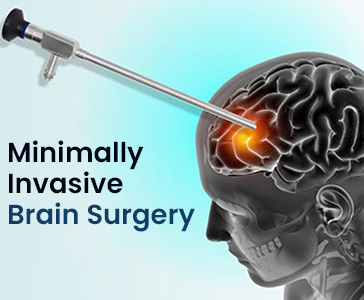Minimally invasive brain surgery is a common treatment for a brain tumour or other conditions affecting the brain. Every year, approximately 80,000 people are diagnosed with a brain tumor, and over 700,000 people live with the disease.
This surgery is frequently used to remove tumours or to treat other conditions such as stroke or epilepsy. It is only one of the tools used by neurosurgeons to repair the brain and treat patients
What are the conditions that necessitate minimally invasive brain surgery?
The brain is the most important organ in the body, controlling and directing all bodily functions. If the brain tissue has been altered by a tumour or swelling, blood flow has been hampered by a haemorrhage or bruising (hematoma), or the cerebrospinal fluid has been impacted by an infection or other illness, minimally invasive brain surgery may be an option.
A stroke or epilepsy may necessitate this type of surgery to remove a brain tumour. Currently, there are 120 different types of brain tumours. These masses are essentially abnormal cell growths that can be cancerous or benign. Surgery is usually the first and primary option for patients who have been diagnosed with a brain tumour.
However, with the advancements in technology and medicine that have led to minimally invasive procedures, the patient may not even require an incision in the skull to perform the procedure.
The concept of keyhole surgery, also known as minimally invasive brain surgery, is the safe removal of brain and skull base tumours through smaller, more precise openings that reduce collateral damage to the surrounding scalp, brain, blood vessels, and nerves.
Modern surgical techniques can reach certain types of tumours through natural openings in the body, such as the mouth or nostrils. To reach the tumor, small incisions the size of a keyhole can be made behind the ear or in the natural eyelid crease.
What exactly is minimally invasive brain surgery (MIBS)?
Many types of tumours within the human skull can now be treated with minimally invasive brain surgery. For years, the techniques have been used successfully in a variety of other procedures, including knee replacement. The goal of minimally invasive brain surgery is to precisely and safely remove tumours or correct issues in the brain while causing the least amount of damage to the surrounding tissue. Many of these procedures can be performed through the nostrils or via a small craniotomy that opens a section of the bony skull.
While any type of brain surgery is risky, minimally invasive techniques reduce the patient’s risk of complications. These surgeries are technically difficult and are not suitable for all types of brain tumours or illnesses.
Today, there are several types of surgery available. They are as follows:
- Microcraniotomy, which involves creating a narrow opening in the skull in order to reach tumours deep beneath the surface of the brain.
- Neuroendoscopy procedures employ specialised endoscopes equipped with a flexible video camera to view inside the brain in preparation for a surgical procedure.
Minimally invasive surgical techniques cannot treat all neurological conditions.
However, these procedures have the potential to treat:
- Brain cysts or tumours
- Brain aneurysms
- Cushing’s Disease
- Epilepsy
- Hydrocephalus
- Parkinson’s Disease
- Pituitary tumours
- Stroke
Biopsies, which take a small sample of tissue from inside the skull to diagnose disease, can be performed during minimally invasive brain surgeries. These procedures may include the placement of a shunt to remove excess fluid from the brain. They can also debulk, or reduce the size of, a brain tumor, or completely remove it.
Minimally invasive brain surgery, like many other types of surgeries, seeks to treat the patient with the smallest incision possible in order to achieve success. Through small keyhole-sized incisions in the skull, nose, or eyelid, an increasing number of patients can now receive minimally invasive treatments for aneurysms, brain tumors, epilepsy, Parkinson’s, and epilepsy. These treatments are frequently preceded or followed by radiation therapy, which does not require any surgery.
In the case of epilepsy, new procedures known as deep brain stimulation implant a tiny electronic device that detects signals and sends them to the parts of the brain responsible for movement. A deep brain stimulator can regulate brain activity in the same way that a pacemaker can regulate heartbeat. This type of surgery is also beneficial for Parkinson’s disease patients.
Is minimally invasive brain surgery more effective than traditional surgery?
Yes. A craniotomy procedure was used in traditional brain surgeries to expose the brain and the tumour affecting it by removing a significant portion of the skull bone. The procedures were more invasive than today’s neurosurgeries, putting patients at greater risk.
Traditional craniotomies and brain surgeries required at least a week in the hospital for recovery. Minimally invasive brain surgeries today aim to minimise disruption to all of the delicate structures in and around the brain, such as the nerves that control vision, smell, and hearing. Operating through a tiny keyhole causes less disruption, less blood loss, and allows the patient to go home in half the time or less than traditional open surgery.
Who is a candidate for minimally invasive brain surgery?
When a patient is diagnosed with cancer, the type of surgery used is determined by the brain tumour.
Patients with skull base tumours (tumors near the bottom of the head) or tumours behind the eyes, nose, or ears may be candidates for minimally invasive brain surgery. Not all patients are eligible. For example, if the patient has a secondary metastatic tumour that began in another part of the body and has spread to the brain, he or she is unlikely to be a candidate for minimally invasive neurosurgery. Traditional craniotomies are the best way to treat tumours in the upper part of the brain.
Before deciding on the best treatment approach, a neurosurgeon will carefully consider the patient’s overall health, age, and symptoms, as well as the location and type of brain tumour.


